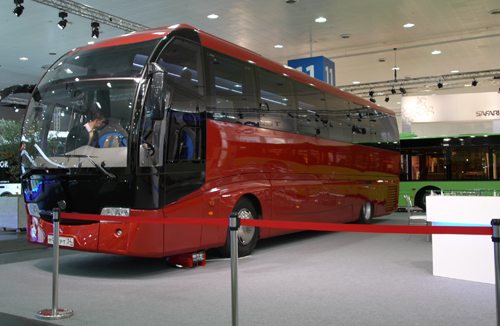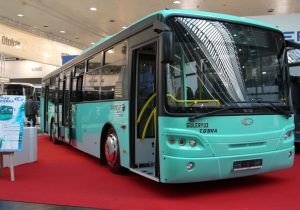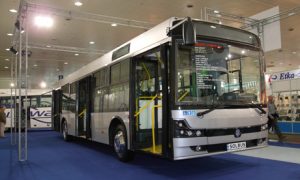
By Doug Jack
Every two years the city of Hanover in northern Germany hosts the largest commercial vehicle exhibition in Europe. The exhibition area is vast with covered halls and large open-air displays with room for the more than 2,000 exhibitors and every kind of commercial vehicle. This year the show welcomed nearly 300,000 visitors from 110 countries.
The show emphasized hybrid propulsion. All the main European bus manufacturers have now developed hybrid products. Several are in the pre-production stage and others are about to go on extended trials with select customers. The OEMs say it will probably be another two years before a wide selection of hybrid products is available as a regular sales option.
Though the hybrid solution varied in the great number of products, each seemed to cost nearly $100,000 above a conventional diesel bus. Bearing in mind the European prices of diesel, manufacturers reckoned that operators would recover the higher price in fuel savings over a six-year period. There is little doubt that, despite some fluctuations, the overall trend in oil prices will continue to rise over the lifetime of a city bus. At least some of the German states are giving grants that cover the increased purchase price of hybrid vehicles.
While most of the components in hybrid buses are tested and proven, there are different schools of thought on electrical energy storage systems. Lithium-ion batteries appear to be gaining in popularity because they hold a high charge for a relatively small size. Bus manufacturers hope that as hybrid vehicles gain in popularity competition between battery manufacturers will lead to lower prices.
This is important because as they currently stand, a set of batteries for a 10-year old bus will cost considerably more than the market value of that vehicle. It might mean that bus fleets have to revise their policies on writing down these vehicles in their accounts.
Volvo Bus Corporation has teamed up with its construction equipment and truck operations to develop a hybrid system they can all use. The I-SAM concept consists of a combined starter motor, electric motor, generator and an electronic control unit. It drives though an electronically controlled multi-speed manual gearbox. The driver does not have to make any shifts. When the vehicle slows down, the lithium-ion batteries store regenerated electrical energy.
The Volvo parallel system uses a small 5-liter diesel engine mounted in the offside rear corner. When the bus stops at traffic lights or to pick up passengers the engine switches off. The bus initially moves solely on electrical power. The diesel engine starts up automatically around 10 to 15 mph and feeds in mechanical power until the diesel engine alone drives the vehicle.
Volvo says that the parallel hybrid system works very well in buses running in suburban traffic with less frequent halts or in lighter city traffic. By having a mechanical coupling between the diesel engine and the drive shaft, Volvo avoids the inefficiency in converting from mechanical power to electrical energy and back again.
Volvo says before the end of this year it will supply six double deck buses with this technology for operation in London. They will feature Wrights bodywork built in Northern Ireland.
MAN and Scania have opted for more compact super-capacitors to store electrical energy, which some say are capable of lasting the lifetime of the vehicle. Both companies plan customer trials in the near future with volume production coming in early 2010.
One totally new Setra
The one totally new Setra vehicle was a 45-ft version of the ComfortClass range. Setra had resisted building to this length, until ALSA, a Spanish customer and subsidiary of National Express of the United Kingdom, placed an order for 100 such vehicles.
This year the modern Setra factory in Ulm will turn out around 3,200 vehicles. The TopClass, ComfortClass and MultiClass families will make up 25 percent each, with the remaining 25 percent made up of Mercedes-Benz interurban and luxury coaches, with some Citaro city buses rounding out the production.
Setra chief executive officer Werner Staib says he is pleased with the U.S. market, which is taking around 150 units. He says Setra is looking at a second offering for U.S. customers and will have more to say in two to three months time.
Setra exports its coaches from Germany throughout Europe. One of the largest orders is from a Turkish customer for 50 double deck TopClass coaches. Used for intensive long distance express service, the high capacity double decks are excellent revenue producers.
Hall 11 is traditionally the home of smaller bus builders and leading industry component suppliers. Temsa of Turkey has added city buses to its range and was showing its Avenue model, cleverly designed to allow the structure to adapt to a full low-floor layout or a low entry option with a conventional rear axle and higher seating at the rear. Either DAF (Paccar) or Cummins engines fit. The first model went to Arriva, Portugal.
Come a long way
Some of the other exhibitors had come a long way to Hanover. Volgabus of Russia showed a full low-floor transit bus that had a complete Western European driveline, with ZF axles and Wabco braking system. One of the company’s representatives joked that the aluminum in the body structure was the sole Russian component. Volgabus has a modern, well-equipped factory and the advantage of much lower Russian labor rates, making its prices highly competitive in Western Europe. The show vehicle was destined for a customer in Dresden, Germany.
Volgabus also showed a coach built on a Mercedes-Benz chassis. The exterior styling is quite attractive, but the interior stills need work to bring it up to acceptable standards. Russia does not have a well-developed component supply industry.
One coach traveled even further. King Long had driven overland from China to Hanover, traveling through Kazakhstan, Russia, Belarus and Poland. The company encountered no technical problems, but was at one stage impounded by the Russian police for a few hours.
King Long and other Chinese manufacturers will have difficulty establishing themselves in Europe. Our top five manufacturers connected with major truck builders offer established parts and service networks throughout Europe. Operators rely heavily on these dealer networks, many with bus experience and unique parts in stock. Contract maintenance is becoming more popular, partly because of the cost of diagnostic equipment for a small fleet. It would cost a Chinese manufacturer a small fortune to establish acceptable parts and service support.
Bearing in mind the state of the financial markets and the banking system, there was a remarkable degree of optimism at Hanover. Bus fleets are reporting increased ridership because people are becoming more selective about using cars. A commuter in a typical European city can purchase a monthly bus ticket for less than the cost of one week’s motoring.
For coach companies the future is less clear. There is strong competition from low cost airlines and heavily subsidized rail systems. Express coach services will continue to prosper because they offer value for money. The extended tour market might suffer some downturn in these difficult times. (See more hybrid bus photos on www.busride.com).
Doug Jack is with Transport Resources in the United Kingdom.




